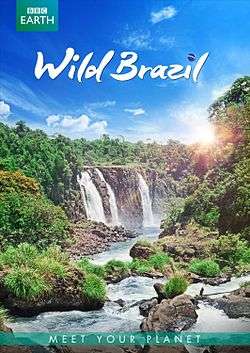Wild Brazil
| Wild Brazil | |
|---|---|
 | |
| Also known as | 'Brazil Gone Wild' |
| Genre | Nature documentary |
| Narrated by | Stephen Mangan |
| Composer(s) | David Mitcham |
| Country of origin | United Kingdom |
| Original language(s) | English |
| No. of episodes | 3 |
| Production | |
| Executive producer(s) | Tim Scoones |
| Producer(s) |
Joe Stevens Adam White |
| Location(s) | Brazil |
| Running time | 50 minutes |
| Production company(s) | BBC Natural History Unit |
| Release | |
| Original network | BBC Two, BBC Two HD |
| Picture format | HD: 1080i / 1080p |
| Original release | 14 January – 16 January 2014 |
| Chronology | |
| Preceded by | Wild Arabia |
| External links | |
| Website | |
Wild Brazil is a British nature documentary series, first broadcast on BBC Two and BBC Two HD in January 2014. Produced by the BBC Natural History Unit and narrated by Stephen Mangan,[1] the three-part series focuses on three animal families, one of tufted capuchins, one of giant otters and one of South American coatis, but also looks at other animals like jaguars. Each episode is followed by a ten-minute Wild Brazil Diaries segment, illustrating the techniques used to film a particular subject.
The series aired in the United States on Discovery Channel, under the title Brazil Gone Wild.
The series forms part of the Natural History Unit's "Continents" strand. It was preceded by Wild Arabia in 2013.
Episodes
1. "A Dangerous World"
- UK broadcast 14 January 2014
The first programme introduces a family of tufted capuchins which live on the cliffs of Piauí (Serra da Capivara National Park), a family of giant otters which make their holts on the banks of the Pantanal and a family of South American coatis which live in the ‘vasantes’ of the southern Pantanal. Each of the families have newborn offspring which are taking their first steps during a brief pause between seasonal extremes.

2. "Facing the Flood"
- UK broadcast 15 January 2014
In the second instalment, some five months of Andes and Amazonian rain forest monsoon cause the mountain streams to swell and start a cascade of flooding, spectacularly affecting Brazilian wildlife. The capuchin monkeys on the cliffs must make the best of a few weeks of abundant vegetation, while offspring must learn fast to become less dependent on mother and fit into the rude group hierarchy. The otters enjoy abundant fish but are hunted by caiman and, like even these, the mighty jaguar. The coatis must retreat higher as their lowland prairies flood, but feast on lungfish in pools and shallow patches.
3. "Enduring the Drought"
- UK broadcast 16 January 2014
In the final episode, a fierce drought ensues, culminating in huge and ferocious fires. The capuchin monkeys, giant otters, coatis and jaguars are proving their extreme survival skills while looking for mates and racing to breed to ensure that the next generation are born just as the good times arrive again.
References
- ↑ "Stephen Mangan Bio". TV Guide. Retrieved 20 June 2015.